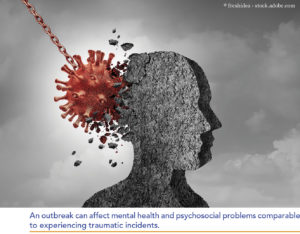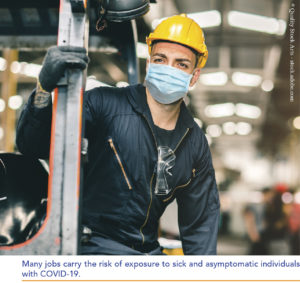COVID-19 Stress Among Your Workers?
Healthy Work Design and Well-Being Solutions Are Critical
A NIOSH Science Blog post
By: Jeannie A. S. Nigam, MS, Jessica M. K. Streit, PhD, MS, Tapas K. Ray, PhD, Naomi Swanson, PhD, Contributors
 Experiencing an infectious disease outbreak can cause fear, anxiety and stress.1-5 Along with overwhelming uncertainty and new behavioral ‘norms’ (e.g., cloth face covering or mask wearing, physical distancing), the COVID-19 pandemic has changed how we meet our daily needs, how we socially interact and whether, how and where we work.1,3 Millions of workers have lost their jobs.6 Some workers have continued to report to a physical workplace, while others have transitioned to full-time telework, and for many, the demands of work have changed or intensified. The nature of each situation is unique, but undoubtedly some of these changes are contributing to increasing levels of economic insecurity and occupational stress.3,7 Reducing occupational stress is a fundamental focus of the NIOSH Healthy Work Design (HWD) and Well-Being program. This post is one in a series of HWD-sponsored blogs addressing the effect of COVID-19 on workers. This post generally describes the stress workers may be experiencing and aims to help employers and policy makers better understand and support workers during this pandemic. Other posts in this series address economic and other insecurity, stress associated with jobs that cannot be done remotely and organizational support.
Experiencing an infectious disease outbreak can cause fear, anxiety and stress.1-5 Along with overwhelming uncertainty and new behavioral ‘norms’ (e.g., cloth face covering or mask wearing, physical distancing), the COVID-19 pandemic has changed how we meet our daily needs, how we socially interact and whether, how and where we work.1,3 Millions of workers have lost their jobs.6 Some workers have continued to report to a physical workplace, while others have transitioned to full-time telework, and for many, the demands of work have changed or intensified. The nature of each situation is unique, but undoubtedly some of these changes are contributing to increasing levels of economic insecurity and occupational stress.3,7 Reducing occupational stress is a fundamental focus of the NIOSH Healthy Work Design (HWD) and Well-Being program. This post is one in a series of HWD-sponsored blogs addressing the effect of COVID-19 on workers. This post generally describes the stress workers may be experiencing and aims to help employers and policy makers better understand and support workers during this pandemic. Other posts in this series address economic and other insecurity, stress associated with jobs that cannot be done remotely and organizational support.
An outbreak can affect mental health and psychosocial problems comparable to experiencing traumatic incidents.8,9 People can suffer increased feelings of uncertainty, anxiety, irritation, anger and denial. It is not uncommon to lack motivation, have trouble sleeping or concentrating and to feel tired, overwhelmed, burned out, sad and even depressed.2 If left unaddressed, experiencing such stress can lead people to engage in maladaptive coping (i.e., increased use of alcohol, tobacco or other drugs, or engaging in other unhealthy behaviors) and chronic health problems and mental health conditions may worsen.2,4 The exact nature of the risks to worker well-being vary according to personal circumstances and work arrangements. Some have had to care for or have lost loved ones. It is important for employers and policy makers to recognize the spectrum of stressors that workers face.
Economic insecurity is affecting the millions who have lost their jobs or have seen their income decrease drastically due to reduced work hours or demand for their services. And those whose jobs are temporarily discontinued may worry about being laid-off and not re-hired, which further impacts emotional health.10,11
Physical Distancing
 Physical distancing by working at home and avoiding in-person meetings or social gatherings can help reduce disease transmission – but also affects access to social support and can result in feelings of isolation and added stress.1 Not all jobs are amenable to remote work. Workers who must continue to report to a physical workplace may experience fear about their health and the health of their loved ones, as well as challenges arranging care for elderly or young dependents. Many jobs carry the risk of exposure to sick and asymptomatic individuals with COVID-19 – such as those in healthcare settings and others (i.e., service occupations) that must be done on-site and require frequent contact with the public. Workers’ well-being can be further impaired if they lose access to health-enhancing benefits available at the formal worksite (e.g., access to on-site health clinics and health and well-being programs).12-15 And those who live or usually work alone may be particularly vulnerable to the “loneliness epidemic” as their infrequent person-to-person contact dwindles further.
Physical distancing by working at home and avoiding in-person meetings or social gatherings can help reduce disease transmission – but also affects access to social support and can result in feelings of isolation and added stress.1 Not all jobs are amenable to remote work. Workers who must continue to report to a physical workplace may experience fear about their health and the health of their loved ones, as well as challenges arranging care for elderly or young dependents. Many jobs carry the risk of exposure to sick and asymptomatic individuals with COVID-19 – such as those in healthcare settings and others (i.e., service occupations) that must be done on-site and require frequent contact with the public. Workers’ well-being can be further impaired if they lose access to health-enhancing benefits available at the formal worksite (e.g., access to on-site health clinics and health and well-being programs).12-15 And those who live or usually work alone may be particularly vulnerable to the “loneliness epidemic” as their infrequent person-to-person contact dwindles further.
Additional concerns can include: the struggle to attend to personal and family needs while working; managing a different workload; lack of access to tools and equipment needed to perform work (including limited or no internet access for remote workers); feelings of not contributing enough to work or guilt about not being on the frontline; uncertainty about the future of the workplace and/or employment; and challenges related to learning new communication tools and dealing with technical difficulties.4 Compounding the risk, workers who already struggle with mental health conditions are particularly vulnerable to experiencing additional emotional symptoms and somatoform disorders during an outbreak,16 and those who must undergo quarantine are at additional increased risk for mental distress compared to workers who are not isolated.17,18
Working at Home
Working at home could be considered somewhat of a luxury during this time. Yet, telework presents its own risks. And, as the home has become the workplace for many, the issue of stress spilling over from one domain to the other has very likely increased.19 Many parents feel conflict when juggling dependent care, trying to oversee children’s remote learning and meet their own work demands. Workers who are not used to telework may be at increased risk of injury if their workspaces are configured without appropriate employer guidance.20 And, while technology use may help workers meet their job demands, it can also extend working hours and further blur work-home boundaries,21-24 which can be consequential for workers and their families. Specifically, workers’ ability to psychologically detach, or “switch off mentally” at the end of the workday can be compromised,25 which has been associated with many indicators of poor well-being, including anxiety, depression, negative affect, emotional exhaustion and fatigue.26
In terms of preventing consequences associated with this altered way of working, there are steps that individual workers can take to build resilience and increase their capacity to detach – such as using a journal to set work-related goals27 and participating in mindfulness.2,4,5,28,29 From an organizational perspective, when supervisors support workers and encourage their efforts to manage work and non-work demands (e.g., increasing control over work and schedule flexibility or offering access to Employee Assistance Programs [EAPs] and paid time off), workers report lower levels of work-family conflict30 and improvements to their sleep,31 schedule control,32 job satisfaction, well-being and physical health.33,34 Early identification of risk factors, strengthening peer support at work and promotion of mental health services (i.e., through remote access) could help workers cope with the ongoing challenges and prevent the onset of maladaptive behaviors.35 WMHS
To read the rest of the blog post and the references, go to: https://tinyurl.com/ydkfvdmj



